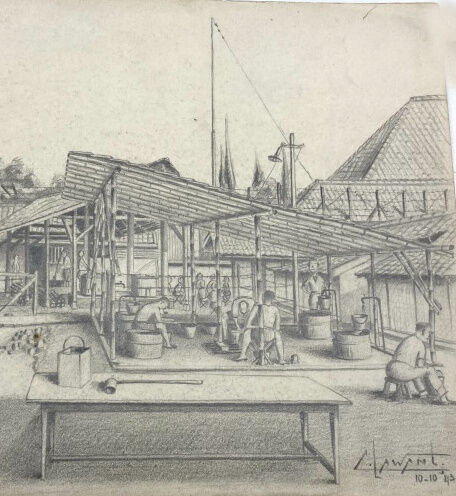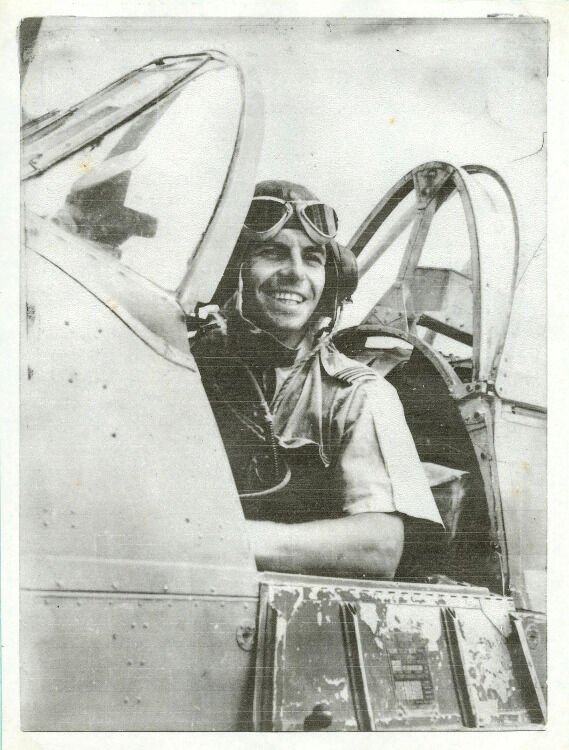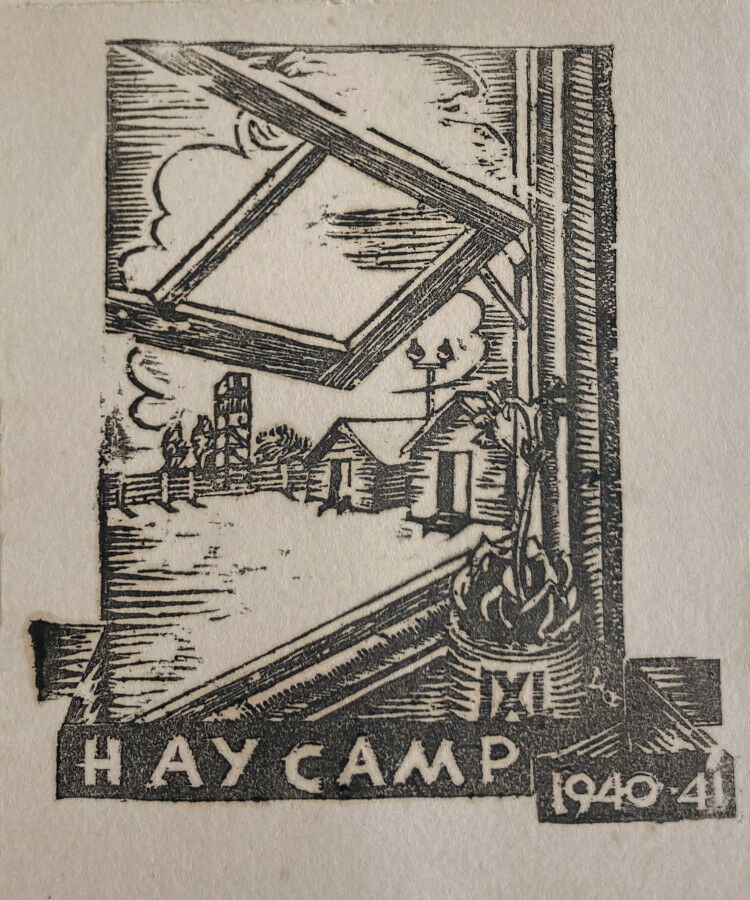Prisoners of War 1939-1945
By Marg Powell, Specialist Library Technician, Metadata | 3 January 2025

Salt water party, Changi, by Murray Griffin, 1942-1943. Courtesy Australian War Memorial, Accession ART24484
Original materials collections - Prisoners of War 1939-1945
The State Library's collections include the stories of capture, treatment, recovery and sometimes death of Queenslanders who were prisoners (POWs) during the Second World War. Between 1939 and 1945 over 30,000 Australians were seized and confined in Europe - Germany, France, Italy, Poland, and Yugoslavia - the Middle East - Turkey, Egypt, Libya, Syria, Jordan and Iraq - the Far East - Singapore, Thailand, Malaya, Burma, Korea, Borneo, Java, Sumatra, as well as New Britain, and New Guinea. More than 8,000 gave their lives.
Through these collections - letters, cards and memoirs, no matter how small - we can honour their service and reserve a place in our collective history, for generations to come.
Prisoners of the Imperial Japanese Army
On 7 December 1941, Japan declared war with Australia, Canada, Great Britain, New Zealand, South Africa and the United States. On this day Japan launched an invasion of Malaya at Kota Bharu; an air attack on Pearl Harbour, Hawaii; the bombardment of the strategic Pacific island of Midway; and the next day began the first bombing of Singapore. These actions propelled Australia into a war that would last almost 4 years.

Prisoners constructing a railway bridge, Thailand. Illustration by Murray Griffin, 1944-1954. Courtesy Australian War Memorial, Accession: ART25016
Singapore, Burma, Thailand, Japan
Almost all Australian servicemen and women who were in Malaya in January-February 1942 were taken prisoner by the Japanese. Initially held at Changi Barracks, in Singapore, the former home of English garrison troops, many were later divided into work parties (forces), and sent to Burma and Thailand where they endured unspeakable conditions including starvation and disease. Here they constructed the infamous Burma-Thailand railway, and some, having survived all this, were sent further away to Japan to work in the mines, where many men died.
The collections held at the State Library are of men from a number of units sent to Malaya, including members of the: 2/10th Field Regiment, 2/105th General Transport Company, 2/26th and 2/30th Infantry Battalions.
Their stories are often intertwined, as they formed unbreakable alliances that aided their survival.
3,000 men commanded by Brigadier Varley, was the first Australian group to leave Singapore for Burma, on 14 May 1942. It was drawn principally from the 22nd Australian Brigade (Brigadier Varley), the 2/4th Machine Gun Battalion (Major Green), and 2/30th Battalion ( Lieutenant Colonel Ramsay), with a medical group drawn mostly from the 2/4th Casualty Clearing Station (Lieutenant Colonel Hamilton)
A Force sailed in the Celebes Maru on 15 May 1942 , from Singapore to Victoria Point, in Burma, where Green's battalion and some other groups (a total of 1,017) disembarked. Ramsey's Force (1,000 men) travelled to Mergui and the remainder continued to the Burma Peninsula near Tavoy. After constructing airfields, A Force moved to Thanbyuzayat in September 1942.
Prisoners of war from Java (Williams Force and Black Force) travelled via Singapore and to Moulmein, arriving in Burma on 29-30 October 1942. Williams Force was based at Tanyin and Black Force at Beke Taung camp at Kilo 40. In October 1942 survivors from the HMAS Perth were shipped to Singapore, and then to Burma. In October 1942, 385 Australians, commanded by Major Robertson, left Java on board the Moji Maru ; they joined with A Force on 17 January 1943.
In all, 479 Australian soldiers died on the Burma section of the railway. Following its completion, in October 1943, men of A Force returned to Singapore and Thailand.
Explore their collections ...
2,242 men under Lieutenant Colonel McEachern left Singapore for Bampong in four groups between 14 and 18 March 1943. Later, D Force moved to Hintok, to work on Pack of Cards Bridge, near Hintok, where McEachern took over the command of Dunlop Force. D Force was also stationed at Kanburi, Tarsau and Konyu, where they worked on Hell Fire Pass (Konyu Cutting).
At the completion of the railway in September 1943 the surviving troops were returned to Singapore, some later being selected to be transported to Japan to work in the mines.
Explore their collections ...
One of the last labour forces to leave Singapore. On 22 April 1943, 3662 Australians and 3400 British troops, many already very ill, were packed into metal railway trucks with little food and water. Their journey took them via Kuala Lumpur, Tanjan Malang, and Penang, arriving at Ban Pong in Thailand 5 days later. The following day F Force began a forced march of over 300km, arriving at Shimo Sonkurai Camp near the border with Burma. Their journey, almost always undertaken at night on foot, took the men 18 days.
F Force was then spread across at least six camps progressing toward the Burma border: Konkoita (no. 4 camp); Shimo (Lower) Ni Thea (Nieke); Shimo (Lower) Songkurai (no. 1); Songkurai (no. 2); Kami (Upper) Songkurai (no. 3) and Changaraya (no. 5).
During the months of May to October 1943, as the railway progressed, prisoners moved between these camps. Australians were mostly located at Shimo Ni Thea, Shimo Songkurai, Kami Songkurai, Konkoita and Tha Khanun. 29 per cent (1060) of the Australians and 60 per cent (2036) of the British prisoners would die.
Explore their collections ...
Indonesia, Java & the Philippines
Not all POWs were members of military forces, but as citizens of the allies at war with Japan, they were interned in countries such as Java, Indonesia and the Philippines.
Alan Douglas Groom, RAAF, RAF (Indonesia) was one of the 5,100 RAF men to become a prisoner of war in Indonesia, in March 1942.
Blog | Collection guide
Catharinus Lawant and his family, originally from the Netherlands were living and working in Indonesia when the Japanese arrived.
Blog | Collection guide
John Dougherty, was supervising production at a sugar mill at Negros Occidental, when the Japanese invaded the Philippines.
Catalogue record

Pencil sketch by Catharinus Lawant of men undertaking kitchen duties at the internment camp, Tjitaroemplein, Bandung, October 1943. 3281, Lawant Family papers and works of art, State Library of Queensland. Item 6
Prisoners of the German Armed Forces
Before Japan declared war in December 1941, many Australian units had been deployed to the fight in the Middle East. Approx. 8,600 Australians became prisoners of the Germans. They included 7,115 Australian soldiers captured in North Africa or Greece; 1,476 airmen, mostly bomber aircrew shot down over Germany; and a number of sailors.

Flight Lieutenant Charles 'Digger' Fry, in his Gloster Gladiator aircraft, 112 Fighter Squadron, Royal Air Force (RAF), Egypt, 1939. 31299 Charles Fry and Beryl Smith correspondence, State Library of Queensland.
Artillery, Airmen and Signallers
James Fearnley, QX6021, Lieutenant, 1st Anti Tank Regiment served in the Middle East from November 1940 and in Greece until May 1941 when he was taken prisoner at Sofia, one of the Greek islands.
Catalogue record | Collection guide | Service record
Charles Fry, Flight Lieutenant, RAF and RAAF, became a prisoner of war in Germany in 1941. Initially located at Gougi, Athens, he was liberated from Stalag Luft III, at Sagan (now Poland).
Catalogue record | Collection guide
Daniel McInnerney, QX8265, 1st Australian Corps Signals was with his unit in Greece when he was captured on 10 May 1941. He was interned in several camps in Germany until being liberated by American troops.
Catalogue record | Blog | Service record
Wilfrid Henry Wood, joined the Royal Air Force Volunteer Reserve (RAFVR). After his aircraft the "North African Star" was shot down he became a prisoner of war in Italy and Germany.
Catalogue record
Prisoners of War, detained in Australia
Enemy Aliens | Civilian Internees | Prisoners of War
Enemy Aliens, came from overseas allies, including Britain, Palestine, Iran, Singapore, Malaysia, Indonesia, New Zealand and New Caledonia; including members of the Jewish German community who had originally been granted asylum in England - Holocaust survivors.
Civilian Internees, Australian-born descendants of migrants born in enemy countries and others who were thought to pose a threat to Australia's security were also detained.
Prisoners of War, 30 nationalities were detained in the Australian internment camps during World War II, with the majority of prisoners being Italians, Germans, and Japanese.
The Dunera Internees
Over 2,500 men were deported from England in 1940 onboard HMT Dunera, including 450 German and Italian prisoners of war, the remainder being Jewish refugees.
Distributed across 3 locations, at Hay and Orange in NSW and Tatura in northern Victoria, they remained interned until they could meet criteria for their release: service with the AIF's 8th Employment Company; sponsored employment / education ; return to the UK to serve with the Armed Forces.
Among the detainees who went on to become nationally and internationally recognised were:
*Artists Ludwig Hirschfeld Mack & Heinz Henghes
*Athletics coach Franz Ferdinand Stampfl MBE
*Composers Felix Werder AM & Boaz Bischofswerder
*Economist Fred Henry George Gruen AO
*Engineer Paul Eisenklam
*Furniture designers Fred Lowen AM & Ernest Rodeck
*Philosophers Kurt Baier & Gerd Buchdahl
*Photographers Hans Axel & Henry Fox Talbot
*Physicist Hans Adolph Buchdahl

Wood block print in the form of a souvenir card, produced by Ludwig Hirschfeld-Mack often given to internees leaving Hay camp, 1940-1941
6341, Wilhelm Rechnitz papers, State Library of Queensland.
- Wilhelm Rechnitz, one of the detainees, made his life in the Christian community, serving for many years in the missions of the Torres Strait. His collection includes items of correspondence from fellow internees and surviving family members who remade their lives after the war.
Further reading ...
- One man's war by Stan Arneil, 1980
- Prisoners of War : Australians under Nippon by Hank Nelson, 1985
- Sandakan the untold story of the Sandakan death marches by Paul Ham, 2012
- 2nd AIF (Australian Imperial Force) and CMF (Citizen Military Forces) unit war diaries, 1939-45 War. Australian War Memorial. [digital]
- Second World War Official Histories, Australian War Memorial. 5 volumes [digital]
SLQ resources ...
Books, Ebooks, Manuscripts (Collections), Videos and more
Watch ...
- Singapore surrender, 15 February 1942 by Nippon Eigasha [Japanese Film] Courtesy Australian War Memorial [18 mins]
- Australian POWs at 10 Cycle Camp, Batavia by Frank McKechnie, 1945. Courtesy Australian War Memorial [2 mins]
- The Australian Prisoner of War experience. Courtesy Australian War Memorial [YouTube, 6 mins]
- Japanese patrol in Tarakan by Leighton Edward Cuffley, 24 September 1945. Courtesy Australian War Memorial [2 mins]
- Video of POW's in Changi prison camp, 1945 by Alan Frederick Anderson. Courtesy Australian War Memorial [4 mins 25 sec]
Comments
Your email address will not be published.
We welcome relevant, respectful comments.